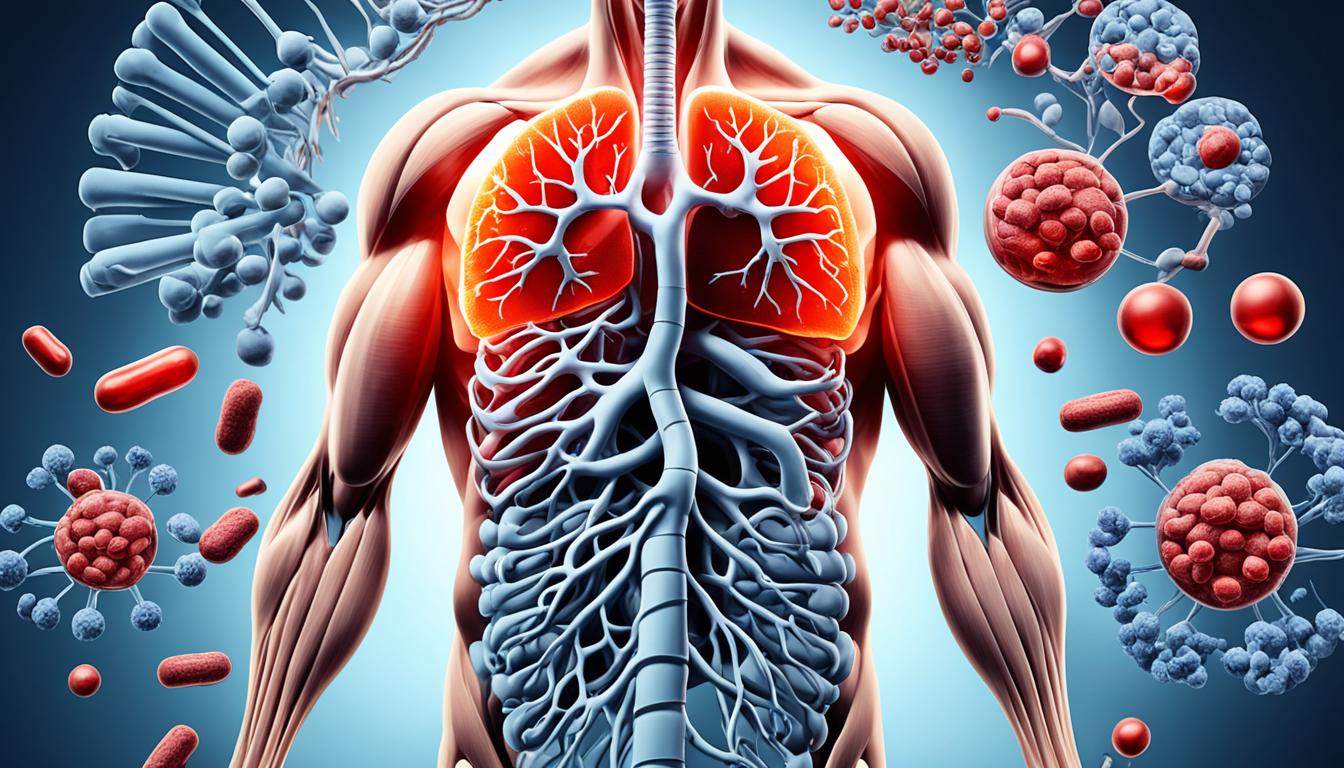Hereditary hemochromatosis is a genetic condition. It causes our bodies to store too much iron. This overload can harm our organs and tissues, leading to serious health issues. It’s quite common, affecting about 1 to 2 in every 500 people, especially those of European descent.
The main victims of this condition are liver, pancreas, heart, and more. The excess iron harms these organs. Symptoms usually appear in adults, affecting men more than women.
This disease has different types. It depends on which gene mutations are involved. The HFE gene, with its C282Y and H63D mutations, is often the cause. These mutations make our bodies absorb more iron, leading to overloading and organ damage.
Doctors diagnose this condition by looking at a patient’s history and doing physical exams. They also take blood tests. These tests measure iron levels in the blood. Usually, genetic tests are needed to confirm the specific gene mutations involved.
The main way to treat this condition is by removing blood. It’s called phlebotomy. This method helps lower iron levels. This prevents further damage to the organs and helps manage the condition’s symptoms.
Key Takeaways:
- Hereditary hemochromatosis is a genetic iron overload disorder.
- Excess iron deposition in the body can lead to dysfunction in multiple organs.
- Men are more commonly affected by hereditary hemochromatosis than women.
- The HFE gene mutations, particularly C282Y and H63D, are commonly associated with the disorder.
- Diagnosis involves evaluating medical history, physical exams, and blood tests.
Symptoms and Diagnosis of Hereditary Hemochromatosis
People with hereditary hemochromatosis may have many symptoms because of too much iron in their bodies. These symptoms range in how bad they are and can involve:
- Joint pain: Many with this condition feel their joints hurt and are stiff, especially in the hands, knees, and hips.
- Fatigue: Being extremely tired or having no energy is pretty common in these cases, due to too much iron.
- Skin discoloration: Some notice their skin turns a bronze or gray color, mostly on their face, neck, and hands.
- Organ damage: Extra iron in the organs can cause trouble and harm. This happens most often in the liver, heart, pancreas, and pituitary gland.
It’s key to remember that not everyone with this condition feels symptoms. In fact, about half of those with the condition feel no symptoms at all. This is called “asymptomatic” or “silent” hereditary hemochromatosis. That’s why getting regular health checks and tests is important, even if you don’t have any symptoms.
Diagnosing this kind of hereditary hemochromatosis goes through a few steps:
- Medical history evaluation: The doctor looks at the patient’s health history and their family’s health history. They check for any signs of or risks for this condition.
- Physical examination: The doctor might also do a check-up to look for signs of too much iron. They could look for skin color changes, joints that hurt, or a liver that’s larger than it should be.
- Blood tests: These are must for spotting hereditary hemochromatosis. They show the levels of transferrin saturation and serum ferritin in the blood. These levels show how much iron is in your body.
- Genetic testing: Sometimes, a test on your genes is done to find specific changes that link to this condition. Usually, these changes are in the HFE gene, like the C282Y and H63D changes.
By looking at health history, doing a check-up, and taking blood tests, doctors can figure out if you have hereditary hemochromatosis. Finding it early is very important. It lets you start treatment soon to avoid or lower the chance of problems.
Causes and Risk Factors of Hereditary Hemochromatosis
Hereditary hemochromatosis comes from changes in the HFE gene. These changes, like C282Y and H63D, make the body absorb too much iron. Too much iron gathers in the body, causing an overload.
This disease is mostly because of parents. Inheriting two mutated genes from them can cause it. But, other situations could lead to the disease as well.
Extra iron from supplements or food can add to the problem. So can lots of blood transfusions. Health issues like severe anemia or liver diseases may cause it, too.
Some people have a higher chance of getting this disease. Having family with it increases your risk. So does being from northern Europe. Men, more than women, also face a greater danger of having it.
Risk Factors for Hereditary Hemochromatosis
| Risk Factor | Description |
|---|---|
| Family History | If someone in your family has it, you’re more likely to get it. |
| Ethnicity | People from northern Europe have a higher risk of hereditary hemochromatosis. |
| Gender | Men face a higher risk of this disease than women do. |
Stem Cell Therapy for Hereditary Hemochromatosis
Stem cell therapy is a new way to treat hereditary hemochromatosis. It aims to fix and grow back tissues and organs hurt by too much iron. The therapy uses stem cells from different places, like bone marrow, fat, and umbilical cord blood.
Special care is taken to use and put these stem cells into the patient. This new treatment is very hopeful. It works by helping the body to repair itself, lessening damage to organs, and making them work better again.
More studies and tests are happening to see how well and safe the therapy is. The findings from these efforts are key. They help us know more about this new method and its benefits for those with hereditary hemochromatosis.

